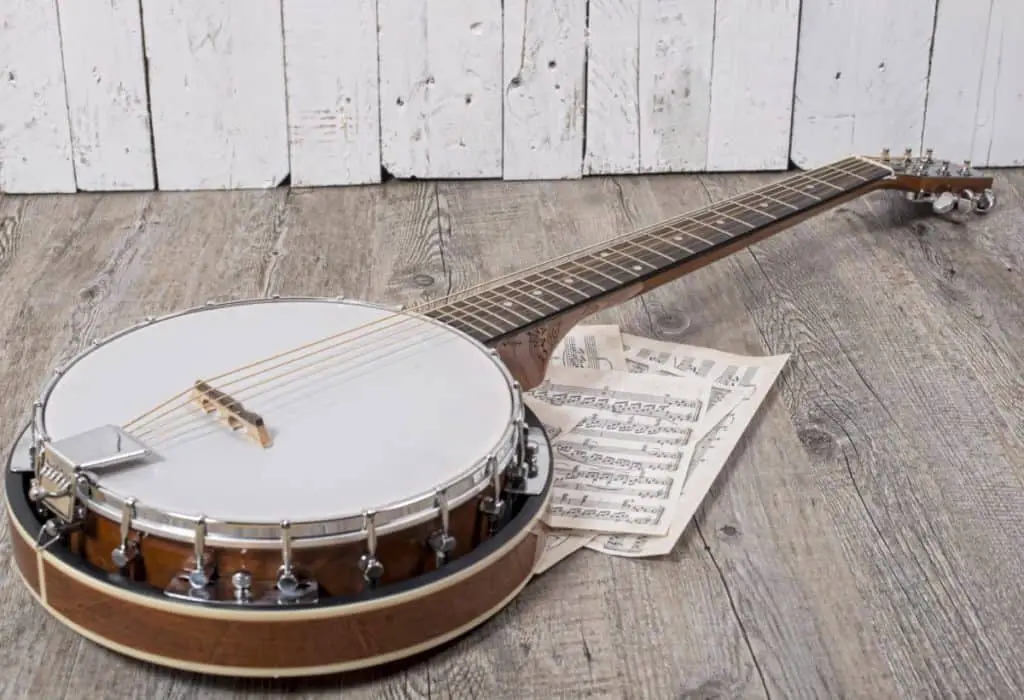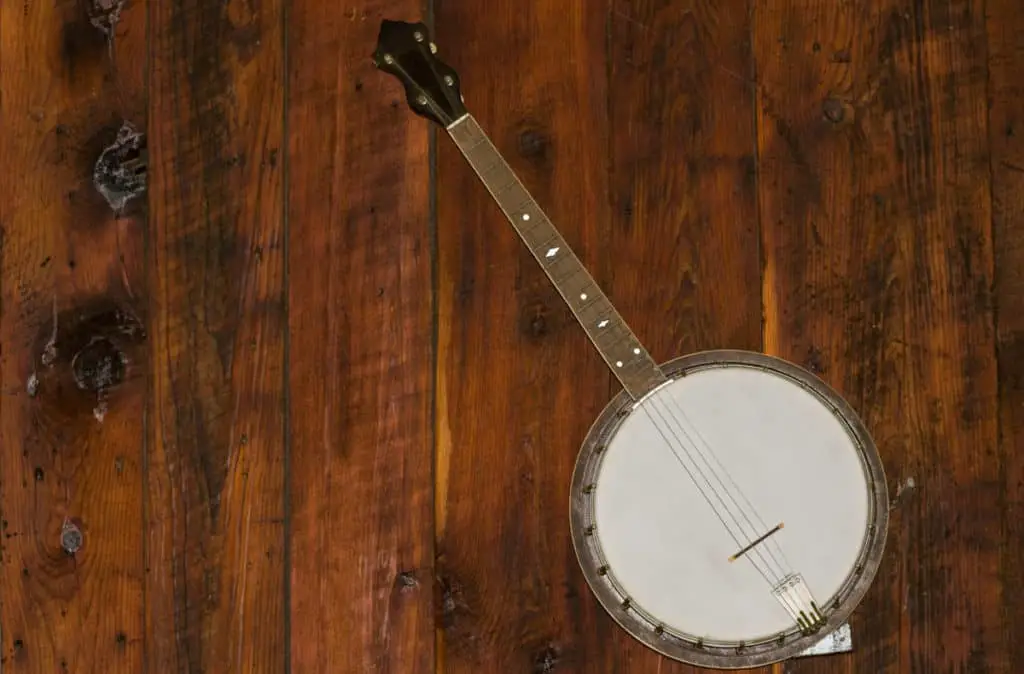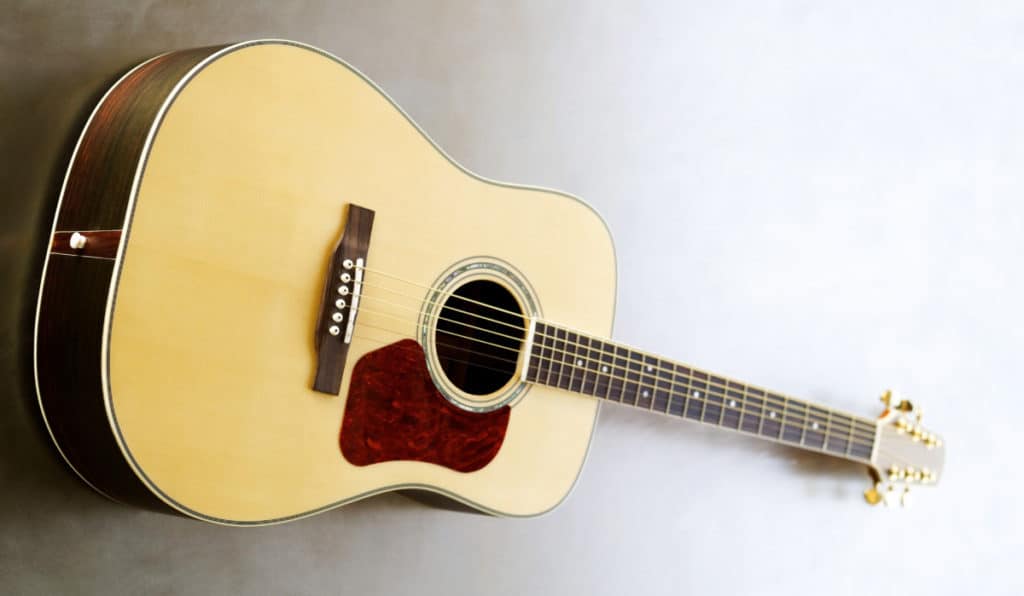The electric/acoustic guitar and banjo are quite similar in many ways, but they’re ultimately different. The electric/acoustic guitar is easily the most popular out of the two, and it’s also the most widely used across a number of different genres.
The banjo, on the other hand, is typically associated with certain musical styles over others. One can easily see the difference between the two after having taken a look at both of them side-by-side, but there are many other fundamental differences between them that aren’t as easy to see.
The primary difference between the banjo and guitar is that the banjo only has 5 strings compared to 6 on the guitar, and it’s tuned to GDGBD. The banjo is also significantly smaller and its body is circular and made out of vellum, plastic, or skin, compared to the all-wooden guitar.
There are many other differences between the two instruments, including their size, body shape, tonality, construction materials, the number of strings, and the aforementioned tunings. The banjo almost always has a tambourine-looking perfect circle body and this plays a huge role in its unique sound.
The Guitar vs the Banjo
Interestingly, the banjo is one of, if not the only, unique instrument that comes from the United States. It was created by black Americans who took inspiration from a much older and traditional African instrument. Additionally, the banjo’s name varied slightly when using different African languages.
It also went by the name, bania, or a banju. Without further ado, let’s dive into some of the differences between the two instruments in detail.
What Separates The Guitar From A Banjo
1) Construction
The construction of the two instruments, including the actual materials, is arguably the most important difference between the banjo and the guitar.
As I said above, the banjo’s strings are laid on top of what looks like a tambourine, whose vellum skin is wrapped over a metal body.
This is responsible for its twangy sound, in comparison to a guitar that tends to produce more of a rich, warm, bright but not too bright, sound.
The stretched skin it’s made out of, in contrast to a resonant piece of wood, has a lot more picking attack but less sustain and harmonic amplification.
Putting it simply, the banjo sounds brighter, it has less sustain and harmonics, and the sound is much, much, thinner as a result of the skin.
The banjo includes a metal resonator panel that the standard guitar does not have. This also plays a big role in its sound. There was a time when guitars used resonator panels a lot more, but these days, most of us just use an amplifier.
It doesn’t take a brilliant musician or audio engineer to notice the difference between a guitar and banjo just after a couple of seconds listening.
The banjo has that southern “twang,” to it, which gives it its goofy and light-hearted vibe.
If you take a look at the image below, you can see exactly what I’m talking about. The banjo literally looks like a snare drum or tambourine with a neck and string attached to it.

An electric or acoustic guitar, on the other hand, is almost always made out of a wooden body, and the resonator hole is much bigger and deeper.
The wooden body, particularly of the acoustic guitar, is responsible for its much deeper sound.

The nylon string guitar, on the other hand, has the same amount of strings as an acoustic guitar, and it’s also tuned the same, but the strings are made out of nylon, and that’s what gives it its characteristic sound.
2) Difference In Tuning
The banjo is tuned to an open G Major chord. In other words, all of the strings are tuned to a note of the G Major chord, they are the following:
1st String: D
2nd String: B
3rd String: G
4th String: D
5th String: G
The notes of a G Major chord are the following, G, B, and D.
The tuning alone makes it drastically different from a guitar.
If you pick up your guitar right now and play a G Major chord, it’s arguably one of the most open and joyful chords there is, and the tuning of the banjo to this chord plays a role in its joyful, cheery, and almost goofy sound.
As most guitar players know, these are the tunings of each individual string:
1st String: E
2nd String: B
3rd String: G
4th String: D
5th String: A
6th String: E
This is called standard tuning, and it’s the tuning that we all know.
Banjos can come in 4-string versions too, but from what I understand, the most common version of the instrument is to have five strings tuned to G Major.
Guitars come in different formats too, including 12-string guitars, 7-string guitars, and 8-string guitars. The basic idea, however, regardless of the strings, is still the same.
3) The Banjo Is Much Smaller
The banjo, as you can see, is much smaller than the regular guitar.
Not only is the body smaller, but the body, headstock, and the rest of it are much smaller as well, making it a lot easier to take on the road with you.
How the neck relates to the body is quite different too. For instance, in contrast to the body’s size, the neck is quite large and long.
If you take a look at the image below, you can see that, compared to the size of the body, the neck is fairly long.

Contrast the aforementioned image with the one of the acoustic guitar down below, where the neck is almost the same length as the guitar.

4) The Number of Strings
As I mentioned above, the banjo typically comes in two different forms, a four-string banjo or a five-string banjo.
In that manner, the banjo kind of resembles the construction of a bass guitar, which is most commonly created with 4-5 strings.
The most common version of the bass guitar has 4 strings, but of course, 5-string or even 6-string bass guitars have become a lot more common over the last few decades, especially in progressive rock and metal.
5) Tonality
I’ve touched on this already, but it’s worth talking about it again.
There are big differences in terms of how the two instruments sound. The acoustic guitar employs a wooden resonator body, that amplifies the sound in such a way that it is much deeper and warm.
Contrast to the banjo which is a lot more “twangy,” has more treble, and is much, much thinner. The way the banjo is built is crucial to its sound.
The guitar, in its most common form, has a chamber and the sound travels from the bridge into the hollow part of the body and echoes out of the sound-hole, the center hole in the guitar’s body.
Contrast that to a banjo, where the sound doesn’t reverberate into a sound-hole or anything similar.
If you take a look at a snare drum, you’ll notice that it looks a lot like the body of a banjo.
The snare drum uses a similar skin to the banjo. It’s what’s responsible for its hollow, thin, sound.
However, of course, the snare drum skin is stretched over little pieces of metal that vibrate and shake whenever the drum is struck.
Regardless, the banjo body is quite similar to a snare drum, due to the fact the skin, vellum, or plastic, is wrapped over the metal body.
This is completely different from an acoustic guitar for obvious reasons, not only in its design and structure, but the materials.
Wood, in comparison to steel and thin skin, will always sound fundamentally different from each other.
6) Body-Shape
The banjo’s body is perfectly circular, or at least close to being a perfect circle.
There is careful attention to detail when it comes to the construction of an acoustic guitar.
It’s designed specifically so that the body is quite large, made out of wood, while at the same time not being too intrusive to the point where you can’t even sit with it.
In other words, there is a trade-off between creating a body that’s conducive to sound while at the same time being able to play it comfortably.
A banjo, on the other hand, relies less on the design of the body. The body-shape of the banjo is not essential to its sound. It’s more about what it’s made out of and what it doesn’t have.
7) Volume
The banjo is also known for being quite loud in comparison to an acoustic guitar. The reason for this is the same as the others mentioned above, the materials that it’s made out of and how it has been constructed and designed.
The banjo, due to its construction, is a treble-heavy instrument, and these frequencies are generally much more audible to the human ear.
For instance, think about the way a bass guitar is much harder to hear in a rock song, in comparison to an electric guitar.
YouTube Video Tutorial
Conclusion
All-in-all, I hope this was very helpful to you. As you can see, while there are some similarities between a guitar and a banjo, the two instruments are very different from each other in several ways.
With that said, the primary difference between them that is crucial in their sound, are its materials and how the actual instrument is designed.

 Written By :
Written By :